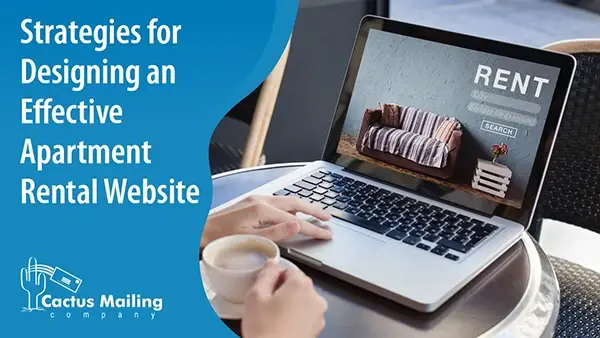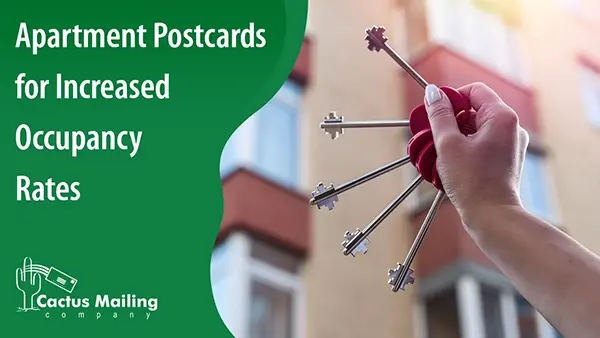We Are Here to Help!
What to Expect from Us:
No Pressure, Just Service!
Get no obligation pricing details and strategies that will work for your business.
Marketing is a pivotal element, especially in apartment rentals. With the rapid progress of digital technologies and consumers' shifting behaviors, the need for creative and forward-thinking marketing tactics has become more crucial than ever to capture the attention of a prospect and ensure the loyalty of current residents.
Successful apartment marketing strategies highlight the living spaces' features and benefits and emphasize the community and lifestyle that come with them. This approach contributes to a vibrant, engaged community that enhances the property's overall appeal.
Apartment marketing demands a balanced blend of creativity, technology, and insight. It's about crafting compelling narratives, leveraging data-driven insights, and delivering exceptional tenant experiences that drive occupancy rates and build a strong, cohesive community. With the right strategies in place, apartment marketers can navigate the complexities of the modern rental market, meet the evolving needs of renters, and ensure their properties' sustained success and growth.
Key Takeaways
- Importance of a multifaceted marketing approach for reaching potential tenants.
- The role of digital and social media strategies in enhancing online visibility.
- Data-driven insights are pivotal for refining marketing strategies and optimizing ROI.
What is Apartment Marketing?
Apartment marketing encompasses a broad range of strategies and channels aimed at promoting rental properties to a prospective resident. The primary objectives of apartment marketing include tenant acquisition, which involves attracting new residents to lease the apartments, brand building to establish a strong and recognizable identity in the market, and community engagement, fostering connections and relationships with current and potential residents to create a sense of belonging and loyalty.
By effectively implementing apartment marketing strategies, property managers can increase occupancy rates, build a positive reputation, and create a vibrant and thriving apartment community.
Property Management Target Audience
To effectively market an apartment complex, it is essential to identify the demographics and psychographics of the target audience. By understanding the age, income level, family status, interests, and preferences of potential renters, personalized marketing strategies can be developed to tailor to different tenant segments.
Understanding diverse demographic groups is crucial for a property manager and marketer to tailor their services, amenities, and marketing strategies to meet the varied needs and preferences of their residents, fostering a vibrant and inclusive community.

Here are some common demographic potential tenant groups for an apartment building:
- Young Professionals: Often single or in a relationship without children, these residents are typically in their 20s to early 30s, starting or building their careers. They tend to value locations with easy access to work, nightlife, and social activities.
- Students: Living either alone or with roommates, students prioritize affordable housing close to educational institutions. They often look for flexible leasing options and amenities like high-speed internet and communal study areas.
- Families: These residents might range from young families just starting out to those with school-aged children. They usually seek larger apartments with multiple bedrooms, proximity to good schools, parks, and family-friendly amenities.
- Retirees and Seniors: Older adults often downsize to apartment living for the lower maintenance lifestyle it offers. They may prefer communities with accessible features, social activities, and close to healthcare facilities.
- Remote Workers: A demographic that has grown recently, these individuals work from home and may prioritize apartments with extra space for a home office, high-speed internet, and quiet environments.
- Pet Owners: Residents who own pets look for pet-friendly apartments that offer amenities like pet parks, walking areas, and pet-friendly policies.
- Lifestyle Enthusiasts: This can include fitness buffs, eco-conscious residents, or art lovers who are attracted to communities that offer specific amenities like gyms, green spaces, or are near cultural venues.
Apartment Marketing Strategies
Leveraging various strategies is key to standing out and attracting potential renters in apartment marketing. From ensuring your property ranks high in search results to engaging with your community on social media, each aspect of your online presence plays a crucial role in your marketing efforts. Here are some core strategies that can help you effectively market your apartments:
Direct Mail Marketing
Direct mail marketing retains value, despite the digital efforts dominating most marketing strategies, especially in real estate and apartment leasing. This traditional form of marketing involves sending a physical marketing material—postcards, brochures, or letters—directly to potential tenants' mailboxes.
Direct mail marketing can be incredibly targeted, allowing property managers to focus on specific geographic areas, demographics, or even individuals interested in moving or renting. For example, using demographic data, you can send customized mailers to young professionals likely to be interested in luxury apartments or families looking for more space and amenities suitable for children.
One of direct mail's key benefits is its tangibility. A well-designed, eye-catching brochure or postcard can make a more lasting impression than a fleeting online ad. It provides something physical that potential renters can refer back to, increasing the chances of your property staying top of mind.
Integrating direct mail campaigns with digital marketing efforts is crucial for enhancing their effectiveness. For instance, including a QR code leading to a virtual tour of your property or a landing page specifically designed for the campaign can bridge the gap between the physical and digital worlds. This provides a seamless experience for the recipient and allows you to track the effectiveness of your direct mail campaign more accurately.
Despite perceptions that it's an outdated approach, direct mailers offer a high ROI for apartment marketing. Its ability to cut through the digital noise and tactile impression makes it a valuable tool in any comprehensive marketing strategy to attract new tenants and fill vacancies.
Search Engine Optimization
A robust online presence begins with a website that ranks well on search engine results pages (SERPs). This requires a strategic approach to search engine optimization (SEO) that includes keyword research to identify terms potential tenants are using to find apartments like yours. Incorporating these keywords naturally into your website's content, meta tags, and alt text for images can improve your site's visibility. Additionally, creating location-specific pages can enhance local SEO, making it easier for potential tenants searching for apartments in your area to find your website.
- Conduct keyword research using tools like Google Keyword Planner or SEMrush to identify terms commonly used by potential tenants searching for apartments in your area.
- Implement these keywords naturally into your website's content, including headings, paragraphs, and image alt text.
- Create location-specific landing pages targeting key neighborhoods or areas within your city to improve local SEO.
- Regularly monitor your website's performance using tools like Google Analytics to track changes in organic search traffic and keyword rankings.

Social Media Marketing
Social media platforms offer a powerful tool for connecting with potential tenants. Each platform has its unique strengths—Instagram is ideal for sharing high-quality images of your properties and engaging stories about community events, Facebook can be used for targeted ads and fostering community through groups, and Twitter offers a platform for real-time updates and conversations. Regularly posting content that is engaging, informative, and reflective of your brand's values can increase your visibility and attract potential tenants.
- Develop a content calendar outlining the types of posts you'll share on each platform (e.g., property photos on Instagram, community events on Facebook, quick updates on Twitter/X).
- Engage with your audience by responding to comments, messages, and mentions promptly.
- Utilize Facebook Ads Manager to create targeted advertisements promoting available units or special offers to users within your target demographic.
- Encourage user-generated content by hosting contests or giveaways that encourage tenants to share their experiences living in your properties.
Apartment Website
Your apartment website serves as a central hub for showcasing available units and providing valuable resources to a prospective renter. Incorporating features such as a blog allows you to offer insights into the local area, tips for apartment living, and highlights of community amenities, positioning your website as a valuable resource for potential tenants. Including a comprehensive FAQ section addresses common inquiries and alleviates concerns, streamlining the inquiry process. Furthermore, ensuring your website is optimized for mobile devices is essential, as a substantial portion of your audience is likely to access it via smartphones.
Digital Advertising
Pay-per-click (PPC) advertising and social media ads can be powerful tools for targeting potential tenants. Platforms like Google Ads and Facebook Ads offer sophisticated targeting options that allow you to reach individuals based on their search behavior, interests, and even their current stage in the apartment-hunting process. Crafting compelling ad copy and combining it with eye-catching images or videos of your property can attract clicks and generate leads. Here's a few examples:
- Set up a Google Ads campaign targeting specific keywords related to apartment hunting in your city or neighborhood.
- Use Facebook Ads Manager to create retargeting campaigns that reach users who have previously visited your website or engaged with your social media content.
- Experiment with different ad formats, such as carousel ads showcasing multiple property photos or video ads highlighting amenities and features.
- Track the performance of your ads regularly and adjust your targeting, bidding strategies, and ad creatives based on insights gathered from analytics platforms like Facebook Ads Manager or Google Ads.
Content Marketing
In content marketing for apartment leasing, a dynamic blend of informative blog content and immersive visual tours forms the backbone of a compelling digital presence. Use your blog to establish your business as a thought leader in the rental market. Topics might include "How to Decorate Your Apartment Without Damaging the Walls," "A Guide to the Best Local Eateries," or "Understanding Your Lease Agreement." These content will provides value to current and prospective tenants and improve your website's SEO, drawing more traffic to your site.
Complement written content with visuals. A prospective renter often expects to see more than just photos before scheduling a viewing. Video tours and 360-degree virtual tours allow prospects to get a feel for the space from the comfort of their current home. These tools are particularly effective for reaching out-of-town renters or those who prefer to limit in-person visits. Videos highlighting community amenities and local attractions can also bolster interest, showcasing the lifestyle that comes with renting an apartment in your complex.

Measuring Success: Key Metrics
To gauge the effectiveness of your apartment marketing strategies, tracking a range of metrics that reflect engagement and conversion is essential. These general suggestions apply across the board, from direct mail to digital campaigns:
- Conversion Rates: Measure the percentage of recipients or visitors who take a desired action, such as filling out a contact form, signing up for a tour, or leasing an apartment. This metric is crucial for understanding how well your marketing efforts directly lead to tangible results.
- Engagement Rates: For social media and content marketing, track likes, shares, comments, and time spent on pages. These metrics offer insights into how compelling and relevant your audience finds your content.
- Website Traffic: Monitor the number of visitors to your website, along with their behavior—pages visited, time on site, and bounce rate. This information can help refine your website's user experience and content relevance.
- SEO Performance: Track your website's ranking for targeted keywords and the volume of organic search traffic. Higher rankings and increased traffic indicate successful SEO optimization.
- Lead Source Attribution: Identify which marketing channels (direct mail, social media, SEO, digital advertising) generate the most leads. This will help you allocate your marketing budget more effectively to the channels with the highest ROI.
- Cost Per Lead/Acquisition: Calculate the cost of acquiring a lead or tenant through each marketing channel. This metric is vital for understanding the efficiency of your marketing spend.
- Open and Response Rates for Direct Mail: For direct mail campaigns, track how many people open your mail and take action. This could be visiting a specific webpage, using a QR code, or calling a phone number provided in the mailer.
- Social Media Growth and Reach: Track the growth of your followers and the reach of your posts to understand how effectively you're expanding your online presence and attracting potential tenants.
- Email Marketing Metrics: If you're using email marketing, monitor open rates, click-through rates, and conversion rates to evaluate the effectiveness of your email content and calls to action.
- Customer Satisfaction and Feedback: After engaging with your marketing efforts or moving in, tenant feedback can provide valuable insights into what's working and what needs improvement.
By monitoring these metrics, you can gain a comprehensive understanding of your marketing strategies' performance. This allows for data-driven decisions that enhance your efforts to attract and retain residents.
Maximizing Tenant Acquisition and Retention
Incorporating a referral program can be a pivotal strategy to maximize tenant acquisition and retention. Leveraging word-of-mouth, one of the most trusted sources for renters, encourages satisfied tenants to refer friends and family, effectively attracting new renters. Offering enticing incentives such as rent discounts, gift cards, or other perks to both the referrer and the new tenant can enhance participation. Promoting this referral program through various channels like email newsletters, social media, and on-site signage ensures maximum visibility and engagement. Additionally, in today's digital landscape, the management of online reviews plays a critical role in a property's reputation. Actively encouraging happy tenants to share their positive experiences on platforms like Google, Yelp, and apartment review sites while professionally and constructively responding to any negative feedback demonstrates a commitment to tenant satisfaction. This approach not only has the potential to improve the experience of a dissatisfied tenant but also significantly boosts the property's appeal to prospective tenants, showcasing an attentive and responsive management team.
Strategies for Lead Generation
Effective lead generation starts with understanding your target audience. Create renter personas based on data from your current tenants and market research. This might include demographics, interests, and what they value in an apartment community. Tailored messaging that speaks directly to these personas can significantly increase engagement and conversions. For instance, if a significant portion of your target audience is young professionals, highlight amenities like high-speed internet, a co-working space, or proximity to nightlife.

Conclusion
Apartment marketing is more than just advertising; it's about smartly blending tactics like engaging social media, effective online ads, and useful content to attract new residents and build a standout brand. Knowing your audience lets you connect deeper, whether through insightful blog posts or immersive virtual tours that make potential tenants feel at home.
Your website is crucial here, acting as your digital welcome mat. It should be inviting, informative, and easy to navigate, making a solid first impression. Digital advertising also plays a significant role, aiming to attract attention and convert viewers into residents by highlighting what makes your community special.
Content marketing elevates this by selling not just an apartment but a lifestyle, showcasing the value of living in your community through various forms of media. Once tenants are in, maintaining that relationship through referral programs and managing online reviews is critical to creating a happy, loyal community.
Your apartment marketing idea must be an artful mix of strategy and creativity, focusing on building a community and making your apartments more than just a place to live but a place people are excited to call home.
Frequently Asked Questions
What are some effective apartment marketing strategies?
Effective apartment marketing strategies include utilizing social media platforms, optimizing your website for search engines, offering virtual tours, and implementing targeted Google Ads campaigns.
How can I attract potential renters to my apartment community?
To attract potential renters, you can leverage social media marketing, create compelling content on your website, showcase positive resident testimonials, and highlight unique amenities of your apartment community.
What role does email marketing play in apartment marketing?
Email marketing is crucial in apartment marketing as it helps nurture leads, engage with current residents, promote upcoming events or specials, and maintain communication with prospective tenants.
How can I improve my apartment's online visibility?
You can improve your apartment's online visibility by optimizing your Google My Business listing, focusing on local SEO strategies, utilizing Facebook Ads, and regularly updating your apartment listing on various rental websites.
What are some innovative apartment marketing ideas to stand out in a competitive market?
Innovative apartment marketing ideas include hosting virtual leasing events, creating 360-degree virtual tours, partnering with local businesses for promotions, and showcasing your property's unique selling points through engaging video content.
How can I effectively leverage content marketing for my apartment community?
By creating valuable and relevant content such as blog posts, videos, and infographics that address your target audience's needs and interests, you can establish your apartment community as a trusted source of information and attract more prospective residents.
Our direct mail postcards have helped many businesses get leads, boost brand awareness, and grow revenue. Let us help you create a marketing postcard design to achieve your marketing goals!

 Cactus Mail Team: Apr 08, 2024
Cactus Mail Team: Apr 08, 2024



 Jill Brown
Jill Brown